|
JULY
2019

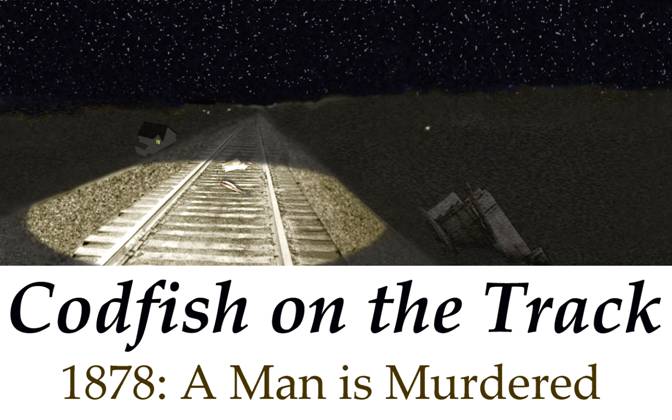
Horse
and Wagon
For
twelve chilly, meandering hours, the horse had been plodding on its way
from one village to the next. Now,
early in the evening of one of the shortest days of the year,
Jericho
's roads were as dark as
Freeport
's had been when the horse set out that morning.
The animal was hungry, and the old fisherman driving the wagon
knew it. And so, Bill Rhodes drove to the Jericho Hotel, right at the
corner where the Turnpike ended at
Main Street
. He tied up his rig and
slung a feedbag from the horse's head.
Content now, the horse began chewing its oats.
Once
inside,
Rhodes
unbuttoned his overcoat and sat down.
A drink would help him warm him up faster.
After chatting with William Horton, the proprietor, for an hour,
Rhodes
was warm enough, and his horse was rested enough.
The fisherman bade Mr. Horton a good night.
Soon the rig was rolling slowly south along the
Jerusalem Road
.
Rhodes
was heading to a poor black community, where he would peddle the rest of
his clams and cod at the end of a long day of fish mongering.
The people there would dicker, and he would lower his prices as
much as he had to. In the
end, his wagon finally would be empty.
*
At
three in the morning, Thomas Cahill was walking where he always walked
with his lantern at that hour, looking over the Main Line's track from
Westbury to
Hicksville
. For much of the way, it
ran along the crest of an embankment, isolated from the farms on either
side. Mostly, the
track-walker was inspecting fishplates - the iron connectors through
which the ends of the 39-foot lengths of rail were bolted together to
keep them aligned. Fishplates
had a way of working themselves loose.
If they were not kept tight, they might cause a train wreck.
About
three-fourths of a mile shy of the
Hicksville
depot, at a spot where the embankment was fourteen or fifteen feet high,
Cahill thought he saw something ahead.
He moved forward, still studying the rails as he walked, and soon
came upon shards of a wooden crate, scattered on the track with some
fish and clams. This was
unexpected; the track-walker lifted his lantern high and looked around.
Beyond the south face of the embankment, where the lantern light
stretched and faded without quite reaching it, something jutted up from
below. It resembled the
corner of a wagon's tailgate. He
clambered part-way down, and the lantern revealed the wreckage of a
wagon that had gone down the embankment.
Why would a fish wagon have been up there?
He climbed back up, crossed the track, and worked his way down
the opposite face. Not
far away, a culvert crossed under the embankment.
As he approached it, he began to make out a pair of motionless
legs which protruded from its mouth.
Again the track-walker lifted his lantern.
Peering into the opening, he saw that the rest of the body was
bloodied, and its skull was crushed.
A
white horse slowly wandered in the adjacent field, nose to the ground,
nibbling. It did not seem
troubled by the broken harness that trailed behind it.
In fact, the horse looked very much at peace with its world.
***
The News
The first reports, written only hours after Thomas
Cahill's gruesome find, opined that the death of
Rhodes
could not have been accidental.
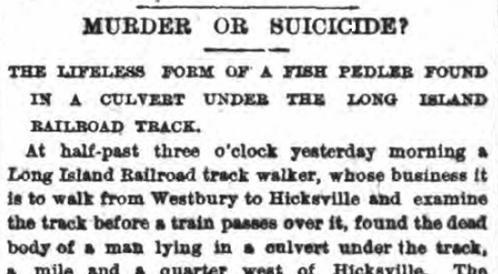
New
York Herald, December 18, 1879
The typo notwithstanding, the Herald seemed quite certain
that the death was intentional.
The nearest crossing at which a wagon could turn
- intentionally or not - to get onto the tracks was a half-mile
distant. Had it gained the
track accidentally, the constant bumping would have alerted the driver
to his error. Regardless,
there were no wheel ruts that led from that crossing onto the track.
Indeed, up on the embankment the wheel ruts began only 200 yards
east of the wreckage. It
would have been impossible for the horse to pull the wagon from there to
where the wagon had fallen, because along the way the animal would have
had to walk over a cattle guard (i.e., a frame with many openings,
recessed between the rails so that a cow or horse would stumble, and not
be able to continue walking along the track). Some people were
speculating that the wagon had been carried up the embankment by a group
of men. And the wreckage
didn't look right, either: there was damage that could not have
resulted from a plunge to the ground.
How had whatever happened to the wagon not injured the horse?
Although the wagon's shafts were broken, part of them remained
connected to the harness that the horse wore.
And of course, the driver's body and the wreckage were found on
opposite sides of the embankment. This
was no accident.
A gory
puzzle like this one would be in the news for quite some time - but as
things turned out, it wasn't.
***
Shouts of a Chicken Thief's
Wife
Quiet
little
Hicksville
had a knack for making the news. A
year earlier, the Dredgers - a man and his two grown sons - were
arrested because their barn was full of stolen items, including about a
hundred chickens. The
Dredgers confessed to the theft of everything found in the barn.
The arrests were duly reported by the newspapers, after which
unknown other thieves promptly emptied the barn, stealing the
almost-recovered property all over again, hens and all. Moral:
In
Hicksville
, don't count your chickens until the police return them to you.
Now,
two days after news first broke of the puzzling death of William Rhodes,
another story put
Hicksville
in the news yet again. The Brooklyn Daily Eagle - the evening newspaper with the largest
circulation in
America
- devoted almost a full column to poultry thefts.
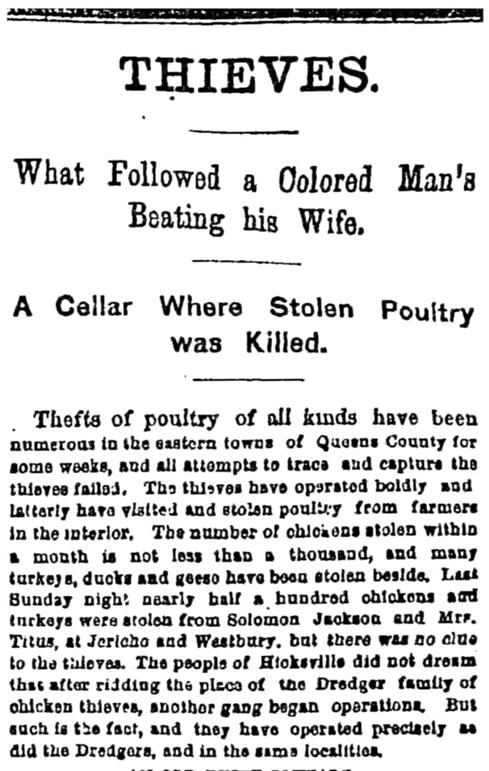
The
Brooklyn
Daily Eagle, December 20, 1878
Ethnic references abounded in the press of the day.
Almost always, African- Italian- Jewish-
Polish- Chinese- and German-Americans who made the news for any reason
were labeled
ethnically. My favorite
example is a story about a man's being rescued from drowning; the
title read simply SAVED BY AN
ITALIAN
An angry, battered woman had shouted to the world that her husband, Pete
Thompson, was a chicken thief. Word
spread, and Thompson was arrested. He
confessed, implicating three others.
He said that the four men (two German-Americans and two
African-Americans) had been responsible for many of the thefts.
Thompson, James Seaman, and a man called Reinhardt were roving thieves; Jacob Gobhardt of
Hicksville
was their fence. Birds were
delivered to Gobhardt's home in
Hicksville
in exchange for cash (six cents per pound for chickens, and a full
dollar - equivalent to twenty-one dollars today - per turkey).
Until slaughtered, the birds were concealed in a secret cellar
that Gobhardt had dug for precisely that purpose.
After he slaughtered a batch of birds, Gobhardt drove to
Brooklyn
, always late at night. He
then took a ferry to
Manhattan
. Come morning, he sold his
ill-gotten poultry. Following
a search of his
Hicksville
property (including the secret cellar below the trap door), Gobhardt was
arrested. Seaman and
Reinhardt could not be found.
The
importance of these arrests could not be exaggerated.
For more than a year, the county had suffered an astounding
incidence of poultry thefts - more than ten thousand chickens per
month. There had been
neither progress nor suspects.
***
An Oyster Planter's Inquest
As news of the chicken ring ebbed, the
Rhodes
story briefly resurfaced. On
the day after Christmas, newspapers reported that Oyster Bay Town
Coroner Valentine Baylis had concluded an inquest into the death.
A few new facts of interest had been divulged:
|
▪
|
Although the wagon was damaged,
little of the damage was caused by its rolling or sliding down
the embankment.
|
|
▪
|
Traces of hair from the wagon
horse's front legs had been found in the boards of the track
cattle guard.
|
|
▪
|
In addition to a fractured skull,
Rhodes
had suffered a wound to his head, a gash so deep that it
penetrated his brain. The
injury had been caused by an axe or similar implement; no such
item was found at the scene.
|
|
▪
|
After selling fish all day,
Rhodes
should have had twenty dollars or more on his person; almost no
money was found.
|
|
▪
|
When last seen, he was wearing his
distinctive overcoat, but no overcoat was found at the scene.
|
In short, there now were more reasons to think his
death suspicious. Nonetheless,
within a week of the incident, the inquest had been adjourned, without
mention or hint of any criminal act.
The peddler's demise was ruled an accident.
How was this possible?
*
In
the 1870s, the towns of Oyster Bay and
Hempstead
each elected a Town Coroner as part of county elections.
Candidates were selected for nomination primarily because they
were well-known and respected - in other words, because voters would
recognize their names. Baylis
had first been nominated because he was a well-regarded oyster
planter, someone proficient at transplanting "seed" oysters to
local beds (a skill vital to the Town's economy).
As part of the winning party's ticket, he was swept into
office. The party and its
coroner were still in office in 1878.
Despite
lacking preparation and training to be a Town Coroner, a man might still
have strengths. For example,
Baylis was shrewd. He was
admired by some for his clever and dogged questioning of uncooperative
witnesses, such as the time he tripped up some criminals who had attempted to misidentify
remains found floating in the waters of Oyster Bay.
On the other hand, the press found it appropriate to recount how
Baylis once had authorized the burial of a body before an autopsy had
been performed.
Cases
like the chicken thefts, or the death of William Rhodes, presented
challenges. The Town's
investigative resources were limited, both in terms of quantity and
quality (e.g., forensic analytical ability).
Coroner Baylis could not create witnesses or evidence out of thin
air. Nor could he create
informants, who seemed to form the backbone of most criminal
investigations in the county. It
appeared that the police never got anywhere unless someone squealed.
Had Mrs. Thompson kept quiet, they still would be ignorant of how
100,000 hens had disappeared without a single cluck, and of whose
pockets had been filled in consequence.
Now,
the coroner's mind was on Hicksville, which was about as far from salt
water as an oyster man could get in the Town of
Oyster Bay
, and Valentine Baylis was well out of his depth.
He could do nothing to promote justice in this case.
*
In
his defense, the citizens who were empaneled for the Coroner's Jury
were worse than no help at all. Much
later, it would be revealed that all the jurors but one had closed their
minds at the outset of the process, for they "knew" what had
happened:
Rhodes
must have spent all the money from his fish sales on whiskey at the
Jericho Hotel, getting hopelessly drunk.
He was there, wasn't he? Then
he accidentally turned onto the railroad tracks from the crossing, and
he drove along until he fell from the embankment and died.
Case closed.
Never
mind that the horse could not walk across the cattle guard.
Never mind the axe gash to the dead man's head.
Never mind the overcoat that wasn't there, or the horse that
wasn't injured from a fall. Those
were just details for someone more clever than they were to explain.
Besides, the jurors had to be rid of all this nonsense, so that
they could go home and prepare for Christmas.
At
first, the lone dissenting juror had tried.
On his own, he visited the scene where everything was discovered,
trying to grasp what had happened that night.
He came back to the jury and argued with the others, but arguing
with them proved futile, and ultimately he gave up.
I surmise that Coroner Baylis gave up as well.
At the inquiry, testimony pointed out all the discrepancies, but
the jury did not listen. It
was not going to reach a verdict other than accidental death.
Even if it did... well, what kind of investigation could the Town
muster? It wasn't as if
some perpetrator's wife was going to shout out the truth in the street
this time around.
The inquest was concluded; there was nothing else to be done.
Outraged, one newspaper reacted bluntly:
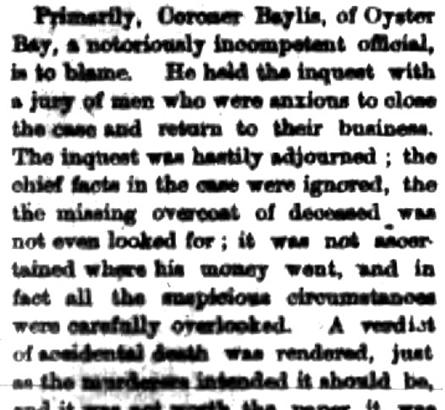
Rockville
Center
South Side Observer, February 13, 1880
***
Shouts of a Different Chicken
Thief's Wife
Through all of 1879, there were no further revelations concerning the
death of
Rhodes
, even though people now and then wrote to the local newspapers and
demanded action. Then one
day, about a month into 1880, something unexpected occurred.
Mary Jane Wood, wife of James Seaman, shouted angry words on the
street where everyone could hear. When
someone blurted out a reply, the wheels of justice for Bill Rhodes
finally creaked and began to turn. The
New York Times printed this:
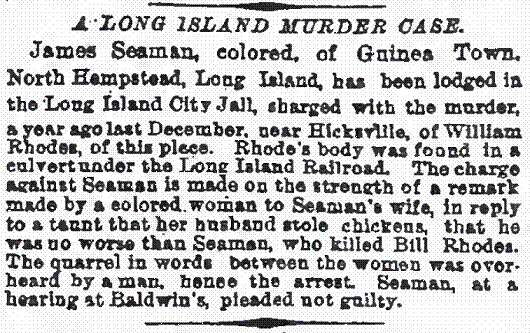
New York Times, January 28, 1880
"Guinea Town," an allusion to the region in the southern part of
Africa's bulge, was a name
sometimes given to free black settlements in the years preceding and
following the Civil War.
In this case, it referred to an area near Rosyln.
I believe it was used much as the phrase
"
China
Town
" is still applied to Southeast Asian enclaves, and was not intended
as a slur.
As had happened earlier with the chicken theft ring, through no
investigative skills of their own, the local authorities had been given
a lead. In fact, the James
Seaman in question was one of the thieves "still being sought" as
part of the chicken-theft ring (but apparently not being sought very
effectively, as he had remained at large nearby).
At the end of 1878, when the news of
Rhodes
' death broke, the Seaman family had suddenly left New Cassel.
At the time, James told the neighbors he was moving because Mary
Jane had "run off with a long-haired Indian."
Although that story may have sounded plausible to him, it did not
convince the neighbors. Now
they understood; James had feared being arrested for the murder of the
fisherman.
Seaman
was questioned on and off over the next few weeks.
In his second interview, he offered a near-confession.
He went on to almost-confess repeatedly, and the facts which he
admitted kept changing. He
had been home the entire night of December 16-17, 1878
(his grown daughter and his wife denied this assertion).
No, he had not stayed home, he had gone out for a walk with
William Weeks (an Irish-American
who since had been imprisoned, having confessed to a number of
burglaries). Neither man
had gone to
Hicksville
. Well, actually, Weeks had,
but he had gone to
Hicksville
alone, while Seaman waited in the cold, sitting on a certain fence (the
investigation showed that the fence he identified was in fact too
pointed to sit on). No,
Seaman made a mistake; he had sat on a different fence.
Seaman had not seen the peddler's wagon that night.
Well, Seaman had seen the wagon, but he had not seen
Rhodes
. Actually, Seaman had been
with Weeks after all. Weeks
had threatened Seaman and his family, so he was with Weeks.
And he had seen Rhodes, too, whom Weeks hit with a club, but
without killing him. Etc.,
etc.
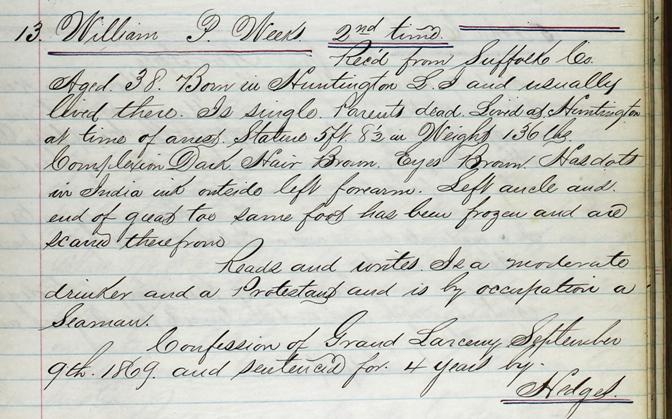
Sing
Sing Prison Admission Register for William P. Weeks, September 1869
A man of many convictions, Weeks served time in several prisons in
New York
State
; this entry,
dating from almost a decade before the killing of
Rhodes
, records his second arrival at Sing Sing.
When
Bill Weeks was interrogated in prison, he denied having seen Seaman for
some time before the incident, or having seen him at all on the night in
question.
Mary
Jane Wood stood her ground. She
said that Weeks had been in her home that night, and he had told her
that he needed money. Weeks
and James had left for a while, and they had returned later with both
money and liquor. Weeks then
remained in the Seaman home for five days, during which he hid whenever
someone came to the door.
Evaluating
all that had been said, constables questioned a number of possible
witnesses and informants, some of whom shed more light on the crime.
Particularly damning was the recovery of the missing overcoat.
After killing
Rhodes
, Weeks hid the victim's coat on a farm near the murder site.
He retrieved it several days afterwards.
When he later volunteered a confession to burglaries, and was
jailed in Riverhead, he gave the coat to a prisoner who was about to be
released. The true purpose
of his generosity was to deflect suspicion from himself, should the
garment ever be recognized as having once belonged to
Rhodes
. Weeks' confessing to
those burglaries had been a senseless attempt to deceive.
For some reason, he had concluded that his going to prison for
the earlier burglaries would remove him from suspicion in the
Rhodes
murder.
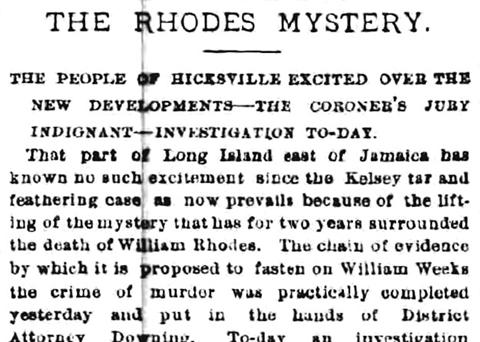
New
York
Herald, February 12, 1880
The Kelsey tar and feathering case?????
***
Trial and Sentencing
Events had unfolded far more productively than they had during the Town
Coroner's efforts, no doubt in large part because this investigation
had a known target from the start.
Justice
Losee of
Hempstead
presided over the trial. The
defendants' efforts to distort the facts and to fabricate alibis
failed to thwart the prosecution. William
Horton of the Jericho Hotel was asked about the hour during which
Rhodes
sat at his bar, and he swore that the fish peddler had remained sober
throughout. Some said
otherwise, but no one dared contradict Horton, for his hotel was a
respectable establishment, which often hosted meetings of the incumbent
County
Democratic Party
. Other patrons who had been
at the
Jericho
that night did corroborate Horton's testimony.
Mary Jane Wood's testimony was believed.
Despite her admitting that the Seaman home long had been used to
conceal criminal fugitives, the press painted her as a rather admirable
and honest woman. The
trial's outcome quickly came into focus.

Sag
Harbor
Corrector, April 24, 1880
Both Weeks and Seaman were convicted of
second-degree murder, and they both were sentenced to life imprisonment.
***
As For the Real Story...
Following the conclusion of the trial, William
Weeks provided a credible statement about the true events of the evening
of December 16-17, 1878.
Rhodes
had started to sell what was left of his fish to people in New Cassel.
In fact, he had knocked on the door of the Seaman home, where
Weeks happened to be visiting at the time.
Making a sale,
Rhodes
had to make change, and in doing so he removed from his pocket what
Weeks and James Seaman mistook for a very large roll of bills.
Thinking he was carrying at least one hundred dollars, the two
men soon went out after the peddler.
They
attacked him in a deserted spot, only to discover that he possessed no
more than eighteen dollars in bills, which had looked like more money
because the bills were wrapped around a roll of paper.
To divert attention from the site of the crime, they drove his
wagon eastward, away from New Cassel, with
Rhodes
inside, lying unconscious. Then
they managed to get the wagon and horse up the side of the railroad
embankment. They started to
drive west along the track, as if
Rhodes
had never made it to New Cassel. Soon
the horse's front legs slipped into the cattle guard, and the
horse's sudden drop broke off the wooden shafts that projected forward
from the wagon. They
extricated the horse and led it down the embankment, leaving it on
farmland. They pushed the
wagon further, and then smashed it to make the staged wreck seem more
serious. Finally, they
rolled it down one side. At
that point,
Rhodes
- perhaps still alive - was thrown headlong down to the culvert from
the other side. Then they
moved his body further into it.
***
Conclusion
Newspapers wrote fancifully about James Seaman's
being a "broken man" whose hair suddenly had turned grey.
What was said about Bill Weeks was more concrete.
He confessed to more crimes, including the unsolved torching of a
shop in
Huntington
. It also was claimed that
he had told one official that his life sentence "would be for the
best," because he would have shelter and regular meals, instead of
constantly living on the run and having to steal to get food.
The two men began their respective life sentences at Sing Sing, one of
Weeks' several alma maters. Seaman
may not have known what to expect at the barren, solid stone complex,
but Weeks did. Prisoners'
lives were tightly regulated there.
To move between their cells and work details (or training
classes, which included knitting!), the men had to march in "lock
step" - tight single file, stepping in unison, each man's hands
resting on the shoulders of the man in front of him.

www.singsingprisonmuseum.org
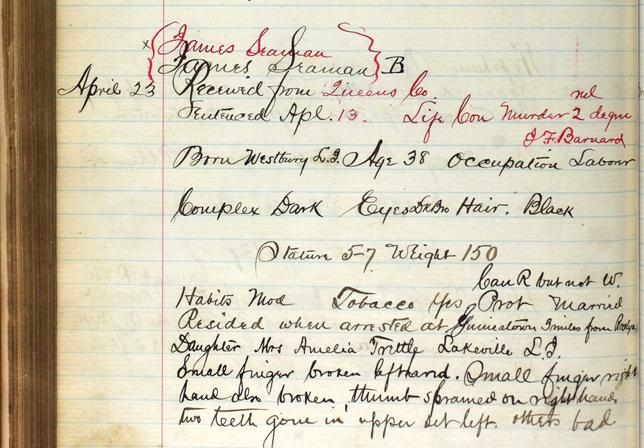
Sing Sing Prison Admission Register for James
Seaman, April 23, 1880
In the end, justice seemed to prevail in this case,
although its circuitous, uncertain route makes one question how often it
got to prevail on
Long Island
during the 1870s and 1880s. All
told, this era probably was not
Hicksville
's finest hour.
***
I've got a Photo Left Over!
Some time ago, I came by this
photograph. I wish that I
could provide a credit for it, but at present I have no idea where I
found it. I offer my sincere
apologies to the unknown source.
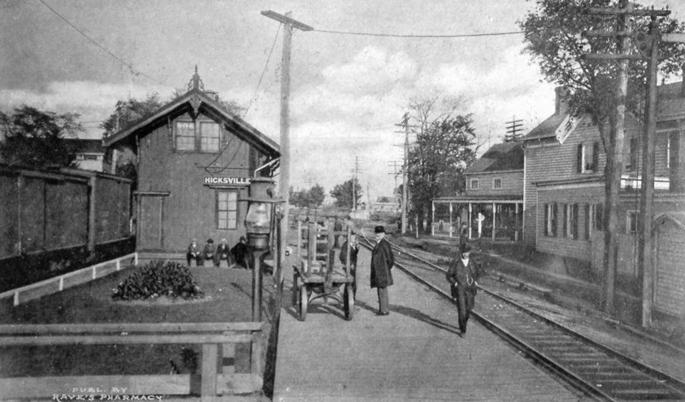
Postcard of
Hicksville
Depot by Rave's Pharmacy
This
is one of the few surviving photographs of the little
Hicksville
LIRR station which existed
when the events described in this article occurred.
The photographer was facing east, standing to the north side of
the
Main Line
, which was then only a single track.
The
Jerusalem Road
was behind him, immediately beyond the water tank that quenched the
thirst of passing steam locomotives.
Looking ahead, Broadway was just beyond the depot, running
through the gap between the two buildings on the right, where the white
sign post can be seen. To
the north (left), the freight yard was filled with wooden box cars.
Just
before 1910, this station was demolished, the tracks through
Hicksville
were rearranged, and a new station was constructed to the west of
Jerusalem Avenue
.
That's it for this month.
***
Ciao!
|











